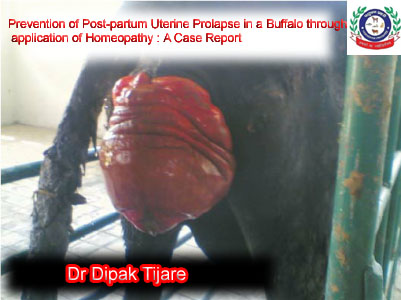Prevention of Post-partum Uterine Prolapse in a Buffalo through Application of Homeopathy : A Case Report
Introduction
Prolapse of uterus is a serious gynecological disorder. It commonly occurs
in cattle and buffalos but may also be seen in other animals and leads to
great economic losses to the farmer. It is one of the obstetrical emergencies
which requires early attention and efficient management. It may
occur due to strong uterine contractions for expelling the fetus, the placenta
or the exudate. Any delay in the management leads to acute congestion,
hemorrhage, necrosis, gangrene and death. Sows and poultry may be
injured due to everted uterus (Ganti Sastrey, 2006).
The present case report is a successful prevention of habitual uterine
prolapse in a Murrah buffalo and its successful management with homeopathic drugs.
History, Clinical Examination and Treatment
A seven year old Murrah buffalo in its third term pregnancy weighing
around 400kg presented with the history of post-partum uterine prolapse
during it’s previous parturitions. During the first delivery it was managed
by the owner and quacks.
In the second delivery, the owner tried to prevent the prolapse but he
failed and then approached me. It was treated first by washing the prolapsed mass of uterus with 1:1000 solution of potassium permanganate.
Positioning of the prolapsed uterus was done by application of ice cubes,
sugar flour and boluses of Nitrofurazone which were placed on the mass.
Then inner repositioning was done and a roap truss on the vagina was applied.
Inj. Avil (Pheniramine maleate)10 ml, Inj. Megamycin (Amoxycillin
+ Cloxacillin) 3 gm and Inj. Melonex (Meloxicam) 20 ml, all for 3 days were
given via intramuscular route. Inj. Hivit 20 ml, 4 doses was given intramuscularly on alternate days and Inj. Calcium barogluconate 450 ml intravenously and Bolus were also given. Involun 1 bid x 3 days was prescribed orally.
The rope truss was removed on the third day of the treatment but
from the fifth day onwards there was a yellowish white fetid discharge from
the vagina with low milk secretion. Now the treatment was changed to
Inj. Cefotaxime (20 mg/kg b.w.) and
Inj.Gentamycin 20 ml, bid x 3 days.
Inj. Beekom – L 20 ml, 2 doses on alternate
days. Bolus Melonex 2 bid x
3 days orally, along with powder Agrimin
forte 50 gm/day with concentrates.
It took about one month to cure the buffalo; the treatment cost became
high and the result was unsatisfactory as the buffalo was yielding low milk
secretion.
During the third gestation (about 8 months), the owner decided to give
homeopathic treatment. Calcarea phosphoricum 30, 10 drops orally was
given twice daily for 10 days and then once in 2 days till parturition. Surprisingly after parturition, there was no prolapse of uterus. The owner was advised to continue giving 10 drops orally, twice daily for 15 days and after that along with Ricinus communis 30.
The owner was pleased with the low cost of treatment, no relapse of condition and increased milk yield.
Discussion
During the second parturition, this case was successfully managed. This
is in correlation with Debasis Jana and Mousamin Jana (2005), as they successfully treated post-partum cervicovaginal prolapse with partial uterine
prolapse in a multiparous indigenous she buffalo. Post-partum uterine prolapse may be due to hypocalcemia that results in atony of gential organs (Pandit Et. al., 982 or mineral imbalances like selenium deficiency (Diminov
and Dimitrov, 1988). Feeding on pastures having estrogen and hormonal
imbalances during pregnancy and after partutition may also cause prolapse
of genitalia (Roberts, 1971). This case was treated with antibiotics, anti-inflammatory, antihistaminic drugs and vitamins, but with unsatisfactory
result. Post-partum uterine prolapse may cause stress to the animal which
is reflected by poor milk yield. Use of homeopathic drugs as preventives
gave successful results with no recurrence of prolapse and increased milk
yield. In this case, prolapse could have been due to hypocalcemia as it responded well to Calcarea phosphorica.
It shows that homeopathic drugs have an upper edge over modern medicines with respect to cost and results in such cases. More study and research is required in these aspects.
References
1. Debasis Jana and Mousamin Jana. Post-partum cervico-vaginal prolapse
with partial uterine prolapse in a pleuriparous indigenous she buffalo. Intas
Polivet, Vol.6(1): 31-31., 2005
2. Diminov, D. and Dimitrov, M. (1988). Levels of selenium in organs of Buffaloes with caudal displacement of genital parts, Proceeding of 4th International Congress, Animal Hygiene, Skara Sweden PP:789-802., 1988
3. Ganti sastrey (2006). Veterinary Pathology, 7th Edition, CBS Publishers
and Distributors, New Delhi. P:431, 2006
4. Pandit, R.K., Gupta, S.K. and Raman, S.R.P. (1982). Ibid, 59:854., 1982
5. Roberts, S.J. (1971). Veterinary Obsterics and Genital Diseases (Theriogenelogy). 2nd Edition, CBS Publication and Distribution, Delhi., 1971
About the author
Dr Dipak Tijare M. V. Sc. and A.H. (veterinary and microbiology) is a veterinary officer and working incharge of Government Veterinary Hospital, Gangadhar, Distt. Jhaawar (Rajsthan). He has been using homeopathic medicines for research and studying the efficacy of homeopathic
drugs in different disease aspects.
Source: The Homoeopathic Heritage, December 2009



